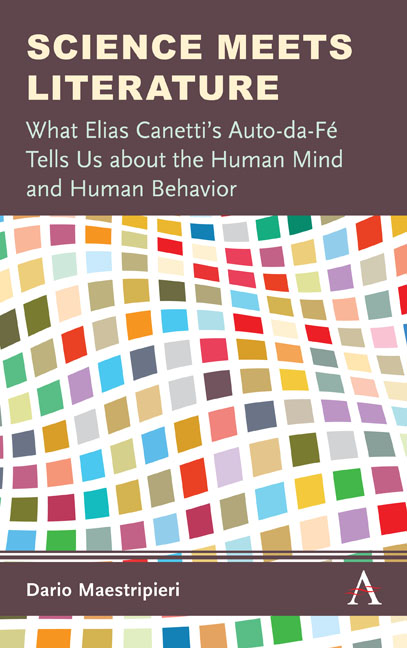 Science Meets Literature
Science Meets Literature Book contents
- Frontmatter
- Contents
- Preface
- Acknowledgments
- Chapter One Why Science and Literature?
- Chapter Two Elias Canetti: A Visionary Literary Genius on a Quest to Understand Human Nature
- Chapter Three The Plot of Auto-da-Fé
- Chapter Four Auto-da-Fé Is a Novel about Human Nature
- Chapter Five Major Themes Running Through Auto-da-Fé
- Chapter Six Analysis of Part I: A Head Without a World
- Chapter Seven Analysis of Part II: Headless World
- Chapter Eight Analysis of Part III: The World in the Head
- Chapter Nine Narrative Strategies in Auto-da-Fé
- Chapter Ten Consilience, the Canetti Way
- Elias Canetti: Chronology
- References
- Index
Chapter Nine - Narrative Strategies in Auto-da-Fé
Published online by Cambridge University Press: 06 July 2019
- Frontmatter
- Contents
- Preface
- Acknowledgments
- Chapter One Why Science and Literature?
- Chapter Two Elias Canetti: A Visionary Literary Genius on a Quest to Understand Human Nature
- Chapter Three The Plot of Auto-da-Fé
- Chapter Four Auto-da-Fé Is a Novel about Human Nature
- Chapter Five Major Themes Running Through Auto-da-Fé
- Chapter Six Analysis of Part I: A Head Without a World
- Chapter Seven Analysis of Part II: Headless World
- Chapter Eight Analysis of Part III: The World in the Head
- Chapter Nine Narrative Strategies in Auto-da-Fé
- Chapter Ten Consilience, the Canetti Way
- Elias Canetti: Chronology
- References
- Index
Summary
An examination of Canetti's narrative strategies in Auto- da- Fé is as important for understanding the author's intentions and the “message encoded in the novel” as the analysis of the content of the novel itself. Canetti's choice and use of particular narrative strategies are not dictated by his personal aesthetic sensitivities, nor can they be traced to the influence of particular literary or artistic movements (any attempts by literary scholars to pigeonhole Canetti into literary modernism or postmodernism inevitably fall short of capturing his unique writing style). Canetti's choice of particular narrative strategies is highly consistent with the topic of the novel and with his strategy for addressing this topic, in terms of characters and plot— in other words, with the overall structure and content of Auto- da- Fé. Therefore, Canetti's narrative strategies can be interpreted as another statement about human nature and the role of the writer in enlightening humankind about its own characteristics and potential for self- destruction.
While the content of the novel focuses on the psychological, behavioral, and social aspects of human nature, through his narrative strategies Canetti expands his exploration of the human experience to include also art and literature. Although Canetti viewed art and literature as enlightening forms of expression, communication, and exploration of the self and the world, he was fully aware that all artistic products are created by human beings for use by other human beings. Therefore, his intuitions about human nature apply also to the production and the reception of art and literature. It would have been inconsistent and contradictory if Canetti had conveyed a particular message with the content of the novel and then a different and contradictory message with the style with which the novel was written. Inconsistent and self- contradictory, however, are not adjectives that easily apply to Canetti, his life, and his work; rather, the most appropriate adjectives to describe him and his approach are “committed” and “rigorous.”
Much has been written about Canetti's narrative strategies in Auto- da- Fé. Richard Lawson described his narrative method as “varied and eclectic” (Lawson 1991, p. 42).
- Type
- Chapter
- Information
- Science Meets LiteratureWhat Elias Canetti's Auto-da-Fé Tells Us about the Human Mind and Human Behavior, pp. 163 - 172Publisher: Anthem PressPrint publication year: 2019


